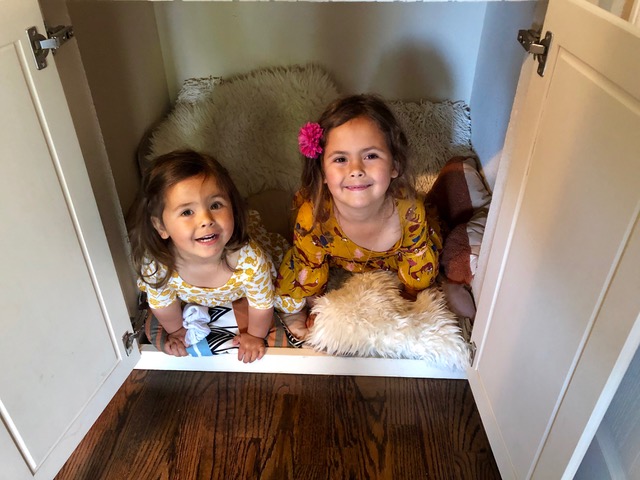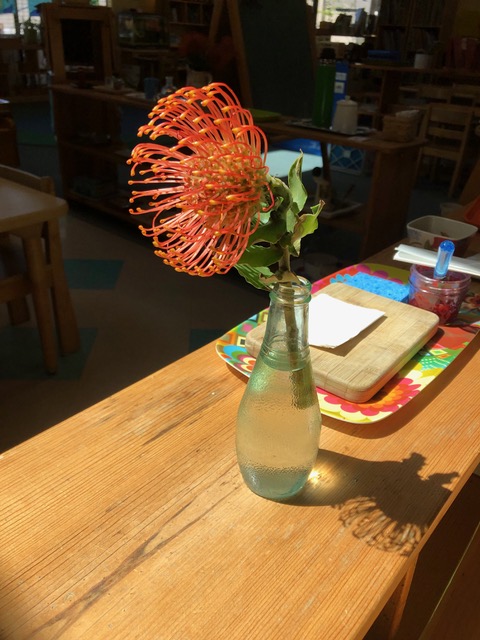The Importance of Beauty in the Montessori Environment The first time I visited a Montessori classroom I was taken aback by its beauty and order. The shelves, made from natural wood, were well organized and clean. The walls were hung with a variety of art, purposefully placed to capture your attention in one place and cause your eye to wander to the next. This classroom’s environment is in harmony, I thought, and I clearly recall the wonderful sense of peace it provided.
I had to know more about this Montessori thing. Just what am I looking at? How did it come to be? So civilized, and beautiful in its orderliness, but without cold rigidity. My guide’s lovely spoken tone reflected her calmness, and her body mechanics as she moved through the classroom were certain yet natural. Was her demeanor part of the Montessori philosophy? I had to ask her. Her reply was an “Aha!” moment for me, as I had long carried a sense that there must be something more for young children. I had discovered it: the Montessori method of education.

Founder Maria Montessori stated “It begins with a knowledge of surroundings”, and also asked “How does the child assimilate his environment?”. Many traditional school settings involve brightly colored objects, and the walls are adorned with colorful, attention-drawing posters. These things are intended to stimulate the young child’s mind, but Dr. Montessori instead set about to stimulate the internal learning desire, keeping external stimulation subdued while encouraging exploration of the materials on the shelf.
Orderliness, cleanliness, and proper presentation are paramount to the Montessori environment. Why so fussy? The young child is immensely impressionable. These “sensitive periods” for learning employ all of their senses, and they absorb every aspect of their environment. We in Montessori insist that all materials are presented in perfect condition at all times. If a piece of something goes missing, the entire item is removed from the classroom until it is once again complete and worthy of being present in that environment.
Humans seek pattern and order; it is the foundation of our learning and intelligence. Learning to return materials to the shelf, ensuring they are beautiful and ready for the next classmate, and along the way fostering an awareness of why this is important, is the essence of the Montessori environment. This sense of order develops naturally and serves the students in many ways throughout their lives. We involve plants and animals in our everyday experiences, developing love and respect for all living things. A simple act of picking garden flowers and neatly arranging them in a vase so that all may admire their beauty brings tremendous, infectious joy to a child.
Your child will grow and become aware of the many complications in our world. Being able to divine some order from that chaos, find balance points, and appreciate the beauty that always surrounds us will improve their well-being. Creating a space that allows a mind to daydream creatively is important, and we encourage our families to have spaces in their home that further fosters this sense. Make a safe and quiet place of their own, with a comfy little chair next to a neat basket of books, and maybe a tiny table with something beautiful upon it like flowers or a photo of what they love most: their family. Let them create this space and manage it, and encourage them as they seek to sweeten their space by helping find flowers and interesting leaves to bring the outside in. Introduce music and other arts, and seek their opinions and impressions about them. Remove things that are unusable or simply no longer used, which creates more space and freedom to explore without clutter.
And let your children guide you. Smell those roses together. Pause, and point out the beauty that is all around us but somehow becomes invisible. Promote some boredom. See where idle time takes them; rein in over-scheduling. Give them time to let life, and its beauty, sink in.
Written by Annie Morris, Head Guide in the Monarch Classroom. She has been teaching at SCM since 1990. She works in our primary program with 3 to 6 year olds.

